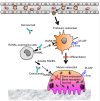A review of denosumab for the treatment of osteoporosis
- PMID: 24748775
- PMCID: PMC3986336
- DOI: 10.2147/PPA.S46192
A review of denosumab for the treatment of osteoporosis
Abstract
Osteoporosis is an age-related systemic skeletal disease characterized by low bone mass and microarchitectural deterioration of bone tissue, with a consequent increase in bone fragility. Bone remodeling involves two types of cells: osteoblasts and osteoclasts. Receptor activator of nuclear factor-κB ligand (RANKL) is a key regulator of the formation and function of bone-resorbing osteoclasts, and its cell surface receptor, receptor activator of nuclear factor-κB (RANK), is expressed by both osteoclast precursors and mature osteoclasts. Denosumab is a fully human monoclonal anti-RANKL antibody that inhibits the binding of RANKL to RANK, thereby decreasing osteoclastogenesis and bone-resorbing activity of mature osteoclasts. Although there are many medications available for the treatment of osteoporosis, inhibition of RANKL by denosumab has been shown to significantly affect bone metabolism. Denosumab appears to be a promising, highly effective, and safe parenteral therapy with good adherence for osteoporosis. Moreover, denosumab may be cost-effective therapy compared with existing alternatives. Therefore, in this review, we focus on studies of denosumab and the risks and benefits identified for this type of treatment for osteoporosis.
Keywords: OPG; RANKL; bone resorption; osteoclast.
Figures

Similar articles
-
Skeletal and extraskeletal actions of denosumab.Endocrine. 2012 Aug;42(1):52-62. doi: 10.1007/s12020-012-9696-x. Epub 2012 May 13. Endocrine. 2012. PMID: 22581255 Review.
-
Inhibition of RANK/RANKL signal transduction pathway: a promising approach for osteoporosis treatment.Med Hypotheses. 2008 Aug;71(2):256-8. doi: 10.1016/j.mehy.2008.03.021. Epub 2008 Apr 28. Med Hypotheses. 2008. PMID: 18445511
-
[The role of rank-ligand inhibition in the treatment of postmenopausal osteoporosis].Reumatismo. 2010 Jul-Sep;62(3):163-71. doi: 10.4081/reumatismo.2010.163. Reumatismo. 2010. PMID: 21052563 Review. Italian.
-
Anti-RANKL antibody was approved for the treatment of osteoporosis in Japan.Nihon Rinsho Meneki Gakkai Kaishi. 2013;36(4):209-16. doi: 10.2177/jsci.36.209. Nihon Rinsho Meneki Gakkai Kaishi. 2013. PMID: 23994799 Review. English, Japanese.
-
Role of RANK ligand and denosumab, a targeted RANK ligand inhibitor, in bone health and osteoporosis: a review of preclinical and clinical data.Clin Ther. 2012 Mar;34(3):521-36. doi: 10.1016/j.clinthera.2012.02.002. Clin Ther. 2012. PMID: 22440513 Review.
Cited by
-
Osteoblastic NF-κB pathway is involved in 1α, 25(OH)2D3-induced osteoclast-like cells formation in vitro.Int J Clin Exp Pathol. 2015 May 1;8(5):5988-96. eCollection 2015. Int J Clin Exp Pathol. 2015. PMID: 26191332 Free PMC article.
-
The role of OPG/RANKL in the pathogenesis of diabetic cardiovascular disease.Cardiovasc Endocrinol Metab. 2018 May 16;7(2):28-33. doi: 10.1097/XCE.0000000000000144. eCollection 2018 Jun. Cardiovasc Endocrinol Metab. 2018. PMID: 31646276 Free PMC article. Review.
-
Leonurus sibiricus L. ethanol extract promotes osteoblast differentiation and inhibits osteoclast formation.Int J Mol Med. 2019 Sep;44(3):913-926. doi: 10.3892/ijmm.2019.4269. Epub 2019 Jul 8. Int J Mol Med. 2019. PMID: 31524244 Free PMC article.
-
Building for better bones: evaluation of a clinical pathway in the secondary prevention of osteoporotic fractures.Eur J Hosp Pharm. 2018 Jul;25(4):210-213. doi: 10.1136/ejhpharm-2016-000906. Epub 2016 Sep 6. Eur J Hosp Pharm. 2018. PMID: 31157022 Free PMC article.
-
IgSF11 regulates osteoclast differentiation through association with the scaffold protein PSD-95.Bone Res. 2020 Feb 10;8:5. doi: 10.1038/s41413-019-0080-9. eCollection 2020. Bone Res. 2020. PMID: 32047704 Free PMC article.
References
-
- Eriksen EF. Normal and pathological remodeling of human trabecular bone: three dimensional reconstruction of the remodeling sequence in normals and in metabolic bone disease. Endocr Rev. 1986;7(4):379–408. - PubMed
-
- Parfitt AM. Osteonal and hemi-osteonal remodeling: the spatial and temporal framework for signal traffic in adult human bone. J Cell Biochem. 1994;55(3):273–286. - PubMed
-
- Karsenty G, Wagner EF. Reaching a genetic and molecular understanding of skeletal development. Dev Cell. 2002;2(4):389–406. - PubMed
-
- Suda T, Takahashi N, Udagawa N, Jimi E, Gillespie MT, Martin TJ. Modulation of osteoclast differentiation and function by the new members of the tumor necrosis factor receptor and ligand families. Endocr Rev. 1999;20(3):345–357. - PubMed
-
- Robbins JA, Schott AM, Garnero P, Delmas PD, Hans D, Meunier PJ. Risk factors for hip fracture in women with high BMD: EPIDOS study. Osteoporos Int. 2005;16(2):149–154. - PubMed
Publication types
LinkOut - more resources
Full Text Sources
Other Literature Sources

